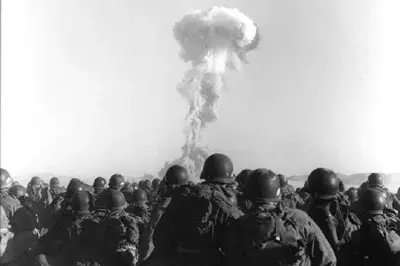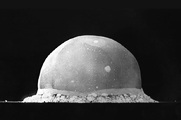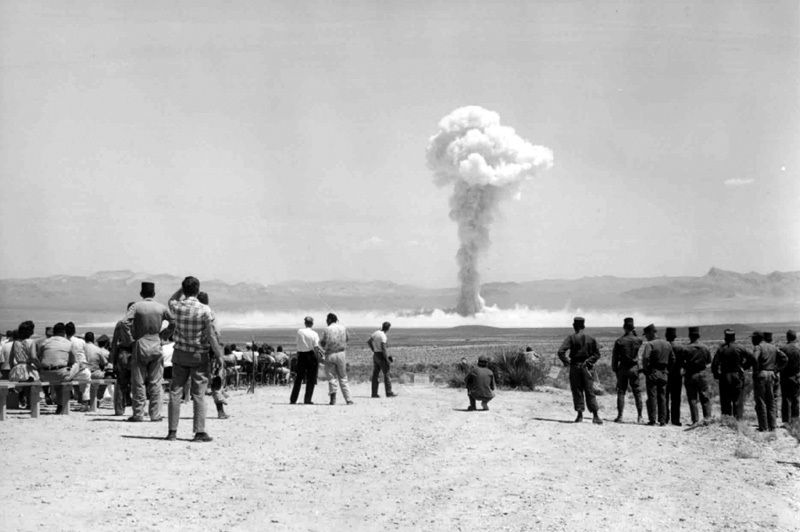This blog post was written by NTI summer interns Katharine Leede and Maggie O’Brien. Leede is in her fourth year at Stanford University, working towards a B.A. in Political Science with a concentration in International Relations and Political Economy and Development. O’Brien received her Bachelor of Arts degree in Political Science from Northeastern University and is working towards her Master of Arts degree in International Relations from the Johns Hopkins School of Advanced International Studies. Leede and O’Brien are working in support of the Communications team at NTI for the William J Perry Project.
At 5:30 AM on July 16, 1945, thirteen-year-old Barbara Kent was on a camping trip with her dance teacher and 11 other students in Ruidoso, New Mexico, when a forceful blast threw her out of her bunk bed onto the floor.
Later that day, the girls noticed what they believed was snow falling outside. Surprised and excited, Kent recalls, the young dancers ran outside to play. “We all thought ‘Oh my gosh,’ it’s July and it’s snowing … yet it was real warm,” she said. “We put it on our hands and were rubbing it on our face, we were all having such a good time … trying to catch what we thought was snow.”
Years later, Kent learned that the “snow” the young students played in was actually fallout from the first nuclear test explosion in the United States (and, indeed, the world), known as Trinity. Of the 12 girls that attended the camp, Kent is the only living survivor. The other 11 died from various cancers, as did the camp dance teacher and Kent’s mother, who was staying nearby.
Diagnosed with four different types of cancers herself, Kent is one of many people in New Mexico unknowingly exposed to fallout from the explosion of the first atomic bomb. In the years following the Trinity test, thousands of residents developed cancers and diseases that they believe were caused by the nuclear blast.
Individuals known as “downwinders,” exposed in communities across the United States have fought for 76 years to receive government recognition. On this anniversary of the Trinity test, we return to the stories of the downwinders in New Mexico and reflect on their pursuit of justice in the face of the world’s deadliest weapons. Their often-forgotten anecdotes uncover the legacy of nuclear test fallout and warn of the risks of nuclear weapon use in the future.
Fallout of the Trinity Test
On July 16, the Trinity Test, nicknamed “Gadget,” detonated near Alamogordo, New Mexico. The total yield of the explosion was 21 kilotons, more than 1.5 times larger than the Hiroshima bomb. The light from the explosion was so bright it could be seen more than 280 miles from the test site, as far as Amarillo, Texas. Nearby residents reported falling from the shock wave, while ranchers recall warm “snow” falling on their cattle and onto their crops for days.
To maintain secrecy, Manhattan Project leaders released a press statement claiming that the explosion was caused by the detonation of ammunition and pyrotechnics. But as government officials departed their state, New Mexico residents were left to live in massive amounts of dangerous fallout. In fact, of the 13 lbs of plutonium in the Trinity bomb, only around 3 lbs exploded. The remaining 10 lbs rose into the atmosphere as a cloud of heavily contaminated soil and debris, casting fallout across an area nearly 250 miles long and 200 miles wide.
In 2010, a report by the Los Alamos Historical Document and Retrieval Assessment Project concluded that radiation in some areas in New Mexico after the Trinity test was 10,000 times higher than what was considered safe exposure levels. The Center for Disease Control and the Los Alamos National Laboratory found that New Mexicans were never warned about the Trinity test nor provided safety or dietary precautions after the blast.
Scientists had offered credible warnings regarding the dangers of radioactive fallout from the atomic bomb since 1940; nevertheless, a public safety team was not established until a month before the Trinity test. Downwinders estimate that families lived as close as 12 miles to the test site, with thousands more residing in a 50 mile radius. Alvin Weinberg, director of the Oak Ridge National Laboratory during the Trinity test, recalled in his memoir that, outside of national security, “all else, including safety, was secondary.”
Health Effects on Communities
After the Trinity test, local doctors across New Mexico began to notice concerning trends in infant mortality rates. In October 1947, a health care provider from Roswell, New Mexico, wrote to Stafford Warren, a radiologist and safety chief of the Trinity operation, regarding the rise in infant deaths in the months after the nuclear test: “As I recall, in August 1945, the month after the first bomb was tested in New Mexico, there were about 35 infant deaths here,” wrote Dr. Kathryn S. Behnke. “I understand the rate at Alamogordo, nearer the site of the test, was even higher than Roswell.”
Warren’s assistant responded to the letter by assuring Behnke that there was no link between infant mortality and fallout. He emphasized that “the safety and health of the people at large is not in any way endangered.” The next month, unpublished data on infant deaths was sent to Los Alamos. More than 70 years later, these documents revealed that the infant death rate in New Mexico was 56% percent higher in 1945 compared to previous years.
Radiation is particularly damaging to developing infants, especially if it’s ingested. In New Mexico, where ranchers collected water from cisterns and drank fresh milk from cows exposed to fallout, newborns were particularly susceptible to fallout from the Trinity test. Many children developed leukemia later in life, which locals attribute to living downwind of the nuclear blast.
Cancer rates among adults also began to climb in the years after the Trinity test. One resident from Tularosa Basin, Gloria Herrera, has a list of 285 friends and family in the community that have died from cancer since the Trinity test. Affidavit after affidavit from New Mexico residents tell the same story of loss. Locals remember fallout blanketing buildings, settling on crops, and raining into their collected water reserve, which was used for bathing and to water the cattle. Survivors recall losing their parents, siblings, children, and nieces and nephews to cancers of all kinds.
The Struggle for Proof
Since the Trinity test was top secret, scientists limited tracking radiation levels in New Mexico following the explosion. As a result, there is little-to-no data on civilian exposure due to the Trinity test in New Mexico. Most significantly, downwinders in New Mexico are excluded from receiving compensation under the Radiation Exposure Compensation Act of 1990 (RECA).
RECA was enacted in order to compensate those who had suffered as a result of the atmospheric testing conducted in the United States. Despite having been expanded in 2000, there are various qualifications required in order to be considered under the current legislation. Claimants fall into three categories: onsite participants, uranium workers, and downwinders. Onsite participants qualify by having been onsite when an atmospheric test was conducted and now suffer from a qualifying cancer. Uranium miners, millers, and transporters qualify by meeting exposure requirements in addition to a qualifying disease. Downwinders only qualify by meeting exposure and disease requirements in select counties of Arizona, Nevada, and Utah. Under RECA, Trinity downwinders, and fallout survivors from other states, are left unrecognized and uncompensated.
The Fight for Recognition
Seventy-six years have passed since the Trinity test in New Mexico. To most Americans, nuclear testing and radiation is only Cold War history. For downwinders, the devastating effects of testing are felt daily in their communities. After decades of fighting for recognition, most people would have given up. Not the downwinders.
Spearheaded by downwinder activists, recent legislative efforts in the House and Senate now include amendments to increase financial compensation, extend the statute of limitations on filing claims, and expand the area covered under RECA to include Colorado, Idaho, Montana, and New Mexico. For those like Barbara Kent, who experienced exposure during atmospheric testing, time is of the essence. The Radiation Exposure Compensation Act is scheduled to expire in July 2022, leaving downwinders across the nation without government recognition.
The survival and suffering of the downwinders is a part of the legacy of the Trinity test and reminds us that nuclear weapons have grave consequences. The persistence of the downwinders teaches us that progress requires patience, and their fight for recognition reminds us that there is still much left to do in the field of nonproliferation.
On the 76th anniversary of the Trinity Test, we must remember and reflect upon the stories of downwinders: the first victims of the atomic age.




